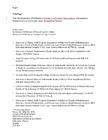Development and validation of providers’ and patients’ measurement instruments to evaluate adverse events after spinal manipulation therapy

Abstract
Introduction: Spinal manipulation therapy (SMT) is used throughout the world by chiropractors, osteopaths, physiotherapists and other manual therapists, yet there are no systematic data collection mechanisms in place to monitor and evaluate adverse events (AE) that occur after SMT. We established a reporting and learning system (“SafetyNet”) to fill this void and to address several aims, one of which is a prospective population-based active surveillance study to (a) document AE after SMT, (b) identify potential risk factors, and (c) develop potential strategies to mitigate risk. The purpose of this paper is to describe the development and validation of provider and patient measurement instruments to identify potential SMT AE in provider offices.
Methods: Instrument development and validation occurred in a step-wise fashion: (1) definition of terms (e.g. adverse event, seriousness); (2) identification and development of key domains, items, and sub-items; and (3) assessment of relevant measurement properties.
Results: Two provider short instruments, a provider long instrument, and a pre and post treatment patient comment instruments were developed, refined, and pilot tested with 12 providers and 300 patients.
Conclusions: The development and validation of instruments to evaluate SMT AEs may benefit the SMT research community as well as clinicians and their patients by providing rigorous prospective assessment of potential SMT-related AEs and their risk factors, thus enhancing patient safety and the promotion of a safety culture. Placing the instruments in providers’ offices for use on consecutive patients is next on the SafetyNet research agenda.
Collections
Date
2014Author
Pohlman, Katherine A
O'Beirne, Maeve
Thiel, Haymo
Cassidy, J David
Mior, Silvano
Hurwitz, Eric L
Westaway, Michael
Ishaque, Sana
Yager, Jerome
Vohra, Sunita